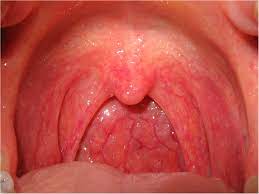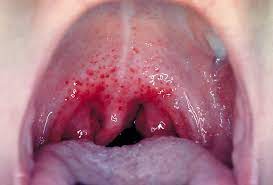
 Sore throat, also known as throat pain, is pain or irritation of the throat.
Sore throat, also known as throat pain, is pain or irritation of the throat.
In the United States, there are about 2.4 million emergency department visits with throat-related complaints per year.
In the United States, about 1% of all visits to the hospital emergency department, physician office and medical clinics, and outpatient clinics are for sore throat, with over 7 million visits for adults and 7 million visits for children per year.
Usually, causes of sore throat include:
viral infections
group A streptococcal infection (GAS) bacterial infection
pharyngitis (inflammation of the throat)
tonsillitis (inflammation of the tonsils), or dehydration, which leads to the throat drying up.
Viral pharyngitis, the most common cause of a sore throat: for which antibiotics are not helpful.
A strong association between antibiotic misuse and antibiotic resistance has been shown
For sore throat caused by group A streptococcus bacteria (GAS), treatment with antibiotics may help the patient get better faster, reduce the risk that the bacterial infection spreads, prevent retropharyngeal abscesses, and reduce the risk of other complications such as rheumatic fever and rheumatic heart disease.
Approximately 35% of childhood sore throats and 5-25% of adults sore throats are caused by a bacterial infection from group A streptococcus.
Sore throats that are non-group A streptococcus are assumed to be caused by a viral infection.
Sore throat: a common reason for people to visit their primary care doctors and the top reason for antibiotic prescriptions by primary care practitioners.
Symptoms of sore throat include:
a scratchy sensation
pain during swallowing
discomfort while speaking
burning sensation
swelling in the neck
The most common cause of sore throat (80%) is acute viral pharyngitis.
Other causes of sore throat include other bacterial infections, such as group A streptococcus or streptococcal pharyngitis, trauma, and tumors.
Gastroesophageal reflux disease can cause stomach acid to back up into the throat and also cause the throat to become sore.
In children, streptococcal pharyngitis is the cause of 35–37% of sore throats.
Clinical guidelines suggest that the cause of a sore throat be confirmed prior to prescribing antibiotic therapy and only recommend antibiotics for children who are at high risk of non-suppurative complications.
A group A streptococcus infection can be diagnosed by throat culture or a rapid test.
Approximately 2/3rd of adults and half of children with sore throat are diagnosed based on symptoms and do not have testing for the presence of group A streptococcus to confirm a bacterial infection.
Test strips detect a cell wall carbohydrate that is specific to GAS by using an immunologic reaction.
Specificity for most rapid tests is approximately 95%, however sensitivity is about 85%.
The use of rapid testing has been linked with an overall reduction in antibiotic prescriptions.
Sore throat can temporarily be relieved by gargling a solution of salt dissolved in water.
Pain medications such as non-steroidal anti-inflammatory drugs (NSAIDs) and paracetamol (acetaminophen) help in the management of pain.
The use of corticosteroids seems to increase slightly the likelihood of resolution and the reduction of pain.
There is only limited evidence to support the idea of drinking a hot beverage.
Lozenges which can help people to cope with a sore throat.
Without active treatment, symptoms usually last two to seven days.
Chief symptom for 7 million office visits to primary care physicians each year and an estimated 18 million sought care for sore throat in 1996, making it the sixth most common cause of visits to physicians.
Estimated that 10% of patients have group A beta-hemolytic streptococcus infection.
Approximately three quarters of adults who visit primary care physicians because of a sore throat receive broad spectrum antibiotics.
